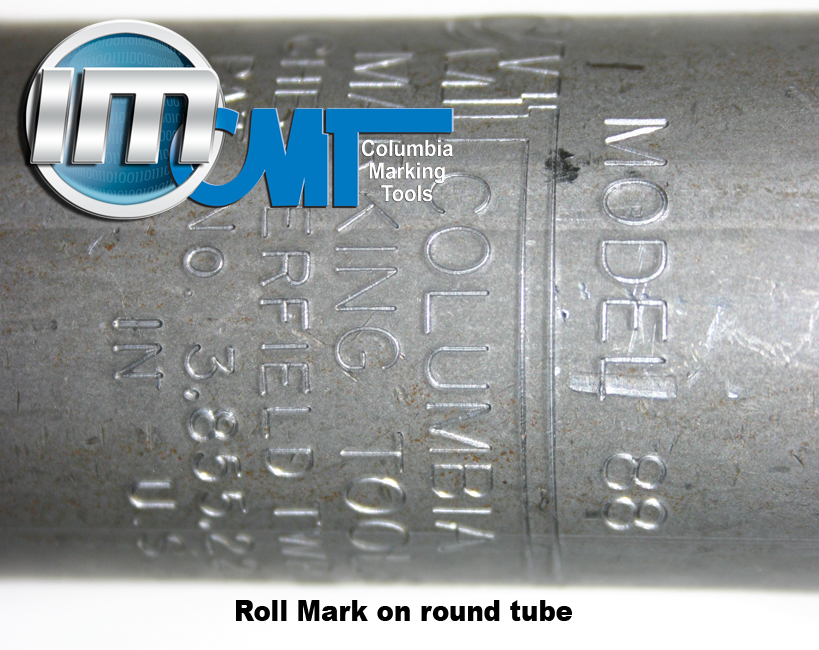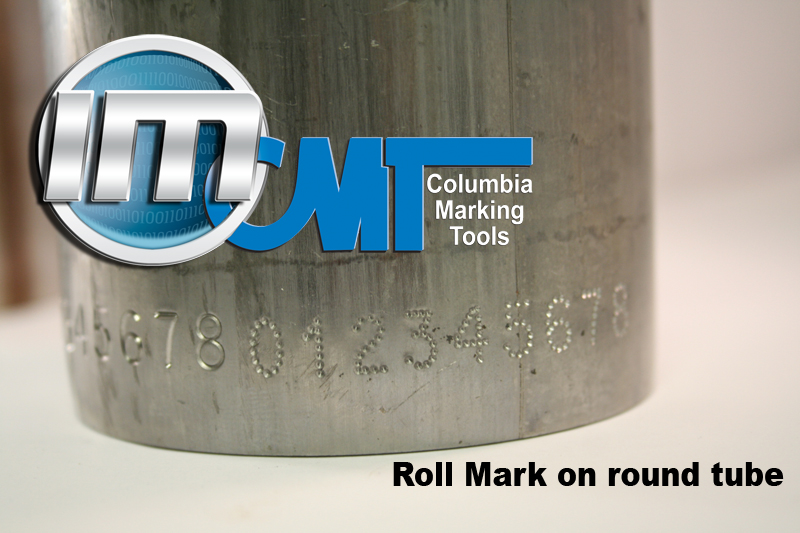MARKING 101
For: Modern Application News
MARKING 101
By: Tom Phipps
Columbia Marking Tools, Inc.
One tool shop estimated it saved one minute per part on their CNC machining center by marking outside the machine.
Another shop estimated it saved $125,000 in labor cost per year using a hand holder instead of hand stamps.
A well-known racecar shop was able to trace parts back to cars that performed well, with respect to those that did not.
A parts manufacture increased sales because people were able to identify his company as the manufacturer.
These are just some of the many reasons why manufacturers should take a closer look at how parts are permanently identified. For this discussion, we will rule out stickers and ink as options because they typically represent an added cost to the part and, for the most part, are not permanent.
For hundreds of years, the old hammer and hand stamp has been used to mark or identify most products…golf clubs and automobile V.I.N. numbers first come to mind. And in some cases, this process still remains the best available marking solution. However, many new marking innovations and technologies, with specific purpose and application, have been introduced and are proving to be better solutions, as well as providing significant cost savings. Traceability is still the best method of analyzing and tracking parts in a manufacturing or production process.
Marking is extremely important because:
- It provides identify now…for the future benefits.
- · It identifies who made it…whatever it is…and when it was made.
Marking 101 Feature Article Cont’d…/2
- And if you’re proud of it, put your name on it.
- A customer should be able to look at a part and know what and where to order it from.
- The sizes, weights, customer job number or whatever…can be applied directly to parts.
Many job shops and manufacturers frequently mention how customers recall “horror stories” about tracking a part or getting blamed for someone else’s bad parts. The solution is to simply mark the part with the customer’s order number, production line or fixture I.D. serial number, company logo or at least the date code on a specific part which quickly identifies it.
Permanently Marking the Part
So how can information be permanently marked into parts? The basic tips for selecting the proper tool, machine or process is simple.
- · How many parts will you mark in a given time? Usually this is rated by day, hour or week.
For example, as a cost savings exercise the next time a part is marked, calculate the time it takes to do it. Then time how long it takes to do more than one part, and then the time it takes to repair a miss-marked part. With most old style hand stamps, it can take up to five minutes to mark a part.
Marking 101 Feature Article Cont’d…/3
Where to start…
What to mark is always the “64 Thousand Dollar question.”
- Does the mark need to be able to provide benefits?
- Does the mark need to identify where more of the same can be ordered?
- Does the mark need to make ordering simpler?
- Is quality, traceability and customer accountability the important factor?
- Is the purpose to promote your company?
These types of marks can include:
- Job numbers
- Date codes
- · Logo or company initials
- · Weight or part size
- · Part numbers
- · New Matrix 2D UID codes (now replacing bar codes)
Marking 101 Feature Article Cont’d…/4
- · Serial Numbers
- · Lot numbers
- · Part size or description
- · Web-site
- · Phone numbers
What size should the mark be?
The most common character size is 1/8-inch (about 73% of the marks are 1/8-inch)… with 3/16-inch running a close second. The following “Static Stamping Pressure Per Character” chart is a good guide to help determine proper marking depth when using automated equipment.
*Materials(sheet metal) .040-in or thinner (Force x .60-in)
Marking 101 Feature Article Cont’d…/5
…and when hand stamping, a hammer blow force chart helps to provide a basic starting point for manual pressing in of marks. Never attempt to hand or impact stamp parts with a hardness above 40Rc .
Estimated Maximum Force per Hammer Blow (in tons)
| Size of Hammer | Average Machinist | Experienced Machinist | Exceptional Machinist |
| 3/4 lbs | 1.5 | 2.0 | 2.5 |
| 1 lbs | 2.2 | 3.0 | 3.7 |
| 1 1/2 lbs | 3.0 | 4.0 | 5.0 |
| 2 lbs | 4.5 | 6.0 | 7.5 |
| 2 1/2 lbs | 6.4 | 8.5 | 10.6 |
| 3 lbs | 11.2 | 15.0 |
Note: Remember…keep marking pressures to a minimum. More characters equal more required area, which means more required power, and ultimately a more costly process. Using lower stress dot style marked characters reduces the required marking force by 55%.
The Typical Hand Stamp Set
Characteristics and limitations include:
- · Hand stamping is good for marks that are applied 1 to 5 times per week
- · Hand Stamps generally take a long time to mark
- · Hand stamps are difficult to keep straight and deep for a professional looking mark
- · Higher tolerance parts might not benefit from getting hit with a hammer
- Cost: Total hand stamp investment is typically $200, for a good complete set.
The Logo Hand Stamp
Characteristics and limitations include:
- · Logos can be any group of characters as well a mark like a phone number or part number
- · Logos are an excellent solution for easily tracing parts
- · Logos are very difficult for others to copy
- · Logos advertise to anyone who sees or touches your part
Marking 101 Feature Article Cont’d…/6
- · Logos should be kept as small as possible to reduce the required hammer blow force
· Cost: Initial logos are typically under $100 while artwork logos are typically under $200.
The Hand Stamp Holder system
Characteristics and limitations include:
- · Hand Stamp Holders are an excellent choice if you mark 1 to 100 parts per day
- · Holders allow marks to be stamped in a straight line every time for better appearance
- · Stamps last longer and cost less when using holders
- · Changing stamps in holders only takes seconds
- · If 10 parts are stamped with the same holder, up to 45 minutes to an hour can be saved over hand stamping with individual stamps. The hand holder system can mark 10 parts in 10 – 20 seconds
- · Cost: a hand stamp system is typically around $300
Conventional Impact Marking
Characteristics and limitations include:
- Simple to apply and cost-effective
- Operates on air pressure
- Very fast process, less that one second per cycle
- Stamp inserts can be changed in under two minutes
- Can be supplied as a “bolt-on” unit or stand alone
- Can mark 1 to 8 characters into non-heat treated steels
- Average cost, depending on application, $150 to $4,000
Squeeze Press Marking
Characteristics and limitations include:
- Generally used for marking flat parts requiring more than 8 characters or a mark must be deep or cosmetically appealing
- This method is used for embossing metal using a male and female die
- Cost range is typically $10,000 to $60,000
Roll Marking
Characteristics and limitations include:
- Most versatile and reliable marking method with greatest range of applications
- Method uses a round wheel-shaped-die that, under pressure, is rolled across a flat part or a flat die is traversed as the part rotates
Marking 101 Feature Article cont’d…/7
- Force against the part being marked is reduce because not all the characters are in contact with the part at the same time
- Parts up to 36-inches diameter can be marked
- Very fast process. 1 to 5 seconds per part
- 2 to 100, 1/16 to 3/8-in size characters can be marked
- Most materials under 48-50 Rc can be marked
- Most round, flat, uneven or cast surfaces can be marked
- Marking machines can be stand alone or automated systems
- Cost range is $7,500 to $45,000. Average system is approximately $12,500
The Programmable Dot Peen System
Characteristics and limitations include:
- · Most machine models are designed for 1 up to 1000 per parts per hour
- · Most machines can mark all types of surfaces including hard,soft, nodular,or smooth
- · Easy menu-driven Windows® software with simple icons and drop down menus make programming very easy
- · Type in what you want to mark, or click on a preprogrammed logo or on any other desired programmed information
- · Programmable Dot Peen markers automatically input dates or serial numbers so the operator does not need to type a new one each time
- · Programmable machines can mark fragile parts because fixturing does not require much clamping force (some parts can be held by hand)
- · Dot Peen marks are very professional looking and allow parts to be marked that would never be possible with hand stamps
- · Marking time is greatly reduced over what can be accomplished on a CNC machining center
- · Cost: entry level systems for most shops range from $3,400 to $8,000.
The Diamond Scribe system:
Characteristics and limitations include:
- · Diamond Scribe Machines are ideal for 1 to 1000 parts per hour
- · Diamond Scribe Machines can mark materials that range from plastics to hard metals
- · Diamond Scribe Machines have all the same features of a DOT PEEN system
- · The Diamond Scribe mark looks like it is engraved…without using milling tools
(more) CMT-121
Marking 101 Feature Article Cont’d…/8
- · Diamond Scribes can mark the new 2D Matrix UID codes which are replacing the common barcodes
- · Diamond Scribe Machines operate like a small CNC machine…very fast and very accurate
- Cost: Machines range in price from $10,000 to $30,000
The Laser Marking System:
Characteristics and limitations include:
- · Laser markers typically fit into a production range of from 1 to 600 parts per day
- · Laser markers are excellent for parts that cannot be touched even by the slightest pressure
- · Laser markers are programmable…like dot and scribe marking systems
- · Laser marking does have a heat treat effect on some parts. For that reason, it is not allowed on most high tolerance or aerospace parts
- · Laser Markers are fast and accurate
- · Laser marks are typically shallow and scratch off of shinny or very smooth surfaces
- · Laser marking fixturing is easy to design and build, but guarding can be a challenge (must be rated for class 4 radiation)
- · Laser markers typically require service contracts
- · Cost: Laser marking systems range from $40,000 to $120,000
Summary
Part traceability and part identification requires processing in the same manner as one would process a part for manufacturing. Considering the purpose of the mark, production quantities and the labor involved are the important factors to consider when selecting the marking process that will produce the right kind of mark in the most cost-effective manner. Evaluating and choosing the right marking equipment and the supplier to provide the best marking solutions should involve broad engineering and product familiarity with the complete range of marking processes.


